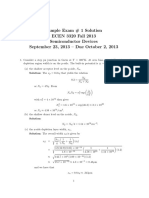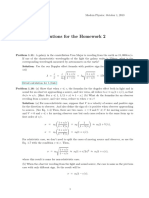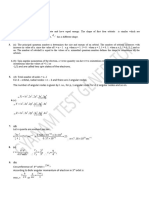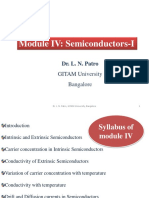1 Exe3 Sol
1 Exe3 Sol
Uploaded by
Tarak BENSLIMANECopyright:
Available Formats
1 Exe3 Sol
1 Exe3 Sol
Uploaded by
Tarak BENSLIMANEOriginal Description:
Original Title
Copyright
Available Formats
Share this document
Did you find this document useful?
Is this content inappropriate?
Copyright:
Available Formats
1 Exe3 Sol
1 Exe3 Sol
Uploaded by
Tarak BENSLIMANECopyright:
Available Formats
Solutions to Chapter 3:
Exercise 3.1: Charge Carriers in Semiconductors
a) Insertion in Equation (3.3):
ΔWG 1.12 eV
− −
2 ⋅8.63⋅10 5 eV/K ⋅ (273.15 K +100 K)
ni = N 0 ⋅ e 2 ⋅ k ⋅T = 3 ⋅ 10 /cm ⋅ e
19 3
= 84 ⋅ 1010 /cm 3
b) Reason for the diffusion current is a concentration gradient of charge carriers; the process is supported
by the thermal lattice movement. Cause of the field current or drift current is an electrical field which
accelerates the charged particles. A stronger lattice movement reduces the mobility of the carriers and
therefore diminishes the field current.
Exercise 3.2: p-n Junction
a) Electrons diffuse due to the concentration gradient as a diffusion current from the n- into the p-doped
region and leave behind in the n-region positively charged donator atoms. As soon as the electrons arrive
in the p-region they fall into holes which results in the generation of fixed negative charges. Based on the
space charges an electric field comes into existence which pushes the electrons as a field current back
into the n-region. After a while a balance is built up between diffusion and field current and a space
charge region is established in the p-n junction.
b) See Figure 3.16.
ΔWG k ⋅ t N02 ΔWG N02
c) VD = − ⋅ ln = − VD ⋅ ln
q q ND ⋅ NA q ND ⋅ NA
(3 ⋅ 1019 /cm 3 ) 2
= 1.12 V − 0.026 V ⋅ ln = 0.865 V
5 ⋅ 1016 /cm 3 ⋅ 1018 /cm 3
Exercise 3.3: Light Absorption in Semiconductors
a) At a penetration depth x = xP the initial irradiance E1 is reduced to E1/e.
Thus:
! 1
E ( x = xP ) = E1 ⋅ e −α ⋅ x P = E1 / e = E1 ⋅ e −1 ⇒ − α ⋅ xP = −1 ⇒ xP =
α
b) With Equation (3.1) and (3.2):
h ⋅ c0 6.6 ⋅ 10 −34 Ws 2 ⋅ 3 ⋅ 108 m/s 3.536 ⋅ 10-19 Ws ⋅ q
WPh = = = 3.536 ⋅ 10-19 Ws = = 2.21 eV
λ 560 ⋅ 10 m
-9
1.6 ⋅ 10-19 As
c) Taken out of Figure 3.22:
c-Si: α(WPh = 2.21 eV) = 6⋅103/cm ⇒ XP = 1/α = 1.67 µm
a-Si: α(WPh = 2.21 eV) = 7⋅104/cm ⇒ XP = 1/α = 0.14 µm
K. Mertens Textbook PV Solutions to Exercises
Exercise 3.4: Anti-Reflection Films
2
n −n
2
1 − 4.6
a) R = 1 2 = = 0.413
1
n + n 2 1 + 4.6
Of the incident 500 W/m2 about 41.3 % are reflected, thus ER = 206.5 W/m2.
b) Optimum refractive index: nS = n1 ⋅ n2 = 1 ⋅ 4.6 = 2.145 ;
λ 600 nm
Optimum film thickness: d = = = 69.9 nm ≈ 70 nm
4 ⋅ nS 4 ⋅ 2.145
λ 600 nm
c) Film thickness: d = = = 75 nm
4 ⋅ nS 4 ⋅ 2.0
2 2
n 2 −n ⋅n 2 2 − 1 ⋅ 4.6
Remaining reflection factor: R = S 2 1 2 = 2 = 0.487 % ≈ 0.49 %
n + n ⋅n + ⋅
S 1 2 2 1 4 .6
K. Mertens Textbook PV Solutions to Exercises
You might also like
- Chen SolutionsDocument10 pagesChen Solutionssujayan2005100% (5)
- Answers of Problems: Biochemical Engineering: A Textbook For Engineers, Chemists and BiologistsDocument32 pagesAnswers of Problems: Biochemical Engineering: A Textbook For Engineers, Chemists and BiologistsMcLovin .MOHNo ratings yet
- Final Exam SolutionsDocument4 pagesFinal Exam Solutionsdredg0661No ratings yet
- HW2 EE3161 SolutionsDocument8 pagesHW2 EE3161 SolutionsdannyNo ratings yet
- CH 23Document28 pagesCH 23Nelson MeiNo ratings yet
- Quantum Mechanics and TheologyDocument13 pagesQuantum Mechanics and TheologyDerek Campbell0% (1)
- Integrated Microelectronic Devices ch1 SolutionDocument13 pagesIntegrated Microelectronic Devices ch1 Solutionexplore THNo ratings yet
- Solutions Atoms Nuclei and Dual Nature JEEDocument7 pagesSolutions Atoms Nuclei and Dual Nature JEEnavdeepkundlas4No ratings yet
- Solutions For HW #2 Problem 1 (1.2 in The Textbook) : N C V N N V VDocument3 pagesSolutions For HW #2 Problem 1 (1.2 in The Textbook) : N C V N N V VAzhar MahmoodNo ratings yet
- Chapter28 Solutions 001Document34 pagesChapter28 Solutions 001Reeja MathewNo ratings yet
- SE1Soln Gate EceDocument8 pagesSE1Soln Gate EcearvindfNo ratings yet
- Solutions To F.F. Chen S Plasma Physics: Tao YeDocument27 pagesSolutions To F.F. Chen S Plasma Physics: Tao YeNorberto Catarino100% (1)
- Sample paper of physicsDocument16 pagesSample paper of physicsbhuvamanish10No ratings yet
- Instant ebooks textbook Modern Physics with Modern Computational Methods Third Edition Solution Manual John Morrison download all chaptersDocument40 pagesInstant ebooks textbook Modern Physics with Modern Computational Methods Third Edition Solution Manual John Morrison download all chaptersgamzebintanvNo ratings yet
- 1587311415phy 102Document7 pages1587311415phy 102Michael Olobu ItodoNo ratings yet
- Final Task TEORIA ELECTROAGNETICADocument9 pagesFinal Task TEORIA ELECTROAGNETICAwilliam torresNo ratings yet
- Physics Assignment 1 SolutionDocument17 pagesPhysics Assignment 1 SolutionKaniyan AhmadNo ratings yet
- Cambridge International ASA Level Physics Study and Revision Guide Third Edition - Test New AnswersDocument6 pagesCambridge International ASA Level Physics Study and Revision Guide Third Edition - Test New Answersadron1232No ratings yet
- EE145 HMWK 5 SolDocument10 pagesEE145 HMWK 5 Soldeepakkr22781No ratings yet
- Chapt 3Document15 pagesChapt 3manjot_cheema0% (1)
- Ncert Class 12 Physics Electric Charges and FieldsDocument39 pagesNcert Class 12 Physics Electric Charges and FieldsfaatinNo ratings yet
- PDF PDFDocument176 pagesPDF PDFMD AJMALNo ratings yet
- Chapter 8 Solutions (Global Edition) : Prob. 8.1Document11 pagesChapter 8 Solutions (Global Edition) : Prob. 8.1성민김No ratings yet
- Milton Rojas - 203058A - 951Document14 pagesMilton Rojas - 203058A - 951Milton RojasNo ratings yet
- JEE Main 2019 Question Paper With Solutions (8th April - Morning)Document67 pagesJEE Main 2019 Question Paper With Solutions (8th April - Morning)Sionna KatiyarNo ratings yet
- Solution - Assignments 2Document5 pagesSolution - Assignments 2Ahmed JamalNo ratings yet
- PHY1032S ClassTest3-2020Document2 pagesPHY1032S ClassTest3-2020lukhanyisojikela12No ratings yet
- DPP - 02 (Video Solution) - ElectrostaticsDocument10 pagesDPP - 02 (Video Solution) - ElectrostaticsHarshit ChaturvediNo ratings yet
- Suggested Solution To 2010 Jc2 Physics Prelims H2 P1: Section A (MCQS) Ans: BDocument17 pagesSuggested Solution To 2010 Jc2 Physics Prelims H2 P1: Section A (MCQS) Ans: BDavid ArdiansyahNo ratings yet
- 252-24hsolvedDocument2 pages252-24hsolvedbilal.ahmed2005No ratings yet
- Fluids HW Chapter 1Document18 pagesFluids HW Chapter 1donpmendoc12No ratings yet
- Ws CH 1ch 2 SolutionDocument6 pagesWs CH 1ch 2 SolutionNoor HassanNo ratings yet
- Phys102 161 Second MajorDocument10 pagesPhys102 161 Second MajorAvneet Singh AroraNo ratings yet
- Week 3 Homework Important Note About WebassignDocument10 pagesWeek 3 Homework Important Note About WebassignJB SibolinaoNo ratings yet
- MIT3 091SCF09 Lec3Document6 pagesMIT3 091SCF09 Lec3Jesús Martínez100% (1)
- Exam2 113-Solution PDFDocument10 pagesExam2 113-Solution PDFXio QueridoNo ratings yet
- Worksheet Solutions 2Document6 pagesWorksheet Solutions 2sera21.rrNo ratings yet
- A-TEST X Sol.Document10 pagesA-TEST X Sol.ramniwashsahkalwarNo ratings yet
- Solutions For The Homework 2Document4 pagesSolutions For The Homework 2arsalanNo ratings yet
- solution-1791925Document7 pagessolution-1791925T jhaNo ratings yet
- Physics Sample Papers 2022-23 KeyDocument28 pagesPhysics Sample Papers 2022-23 KeyOJASisLiveNo ratings yet
- Bohr ModelDocument7 pagesBohr ModelarizkhankolNo ratings yet
- Atomic Structure SolDocument9 pagesAtomic Structure SolMahesh JagtapNo ratings yet
- Solutions of Exercises and Problems: AppendixDocument98 pagesSolutions of Exercises and Problems: Appendixvasudevan m.vNo ratings yet
- Solution To 2010 VJC Prelim H2 P1Document9 pagesSolution To 2010 VJC Prelim H2 P1cjcsucksNo ratings yet
- Physice Chapter 12Document5 pagesPhysice Chapter 12Sam SanthiNo ratings yet
- Physics Assignment 2Document15 pagesPhysics Assignment 2Vines 747100% (1)
- E2 121 09-PreviewDocument14 pagesE2 121 09-PreviewTremendous JohnsonNo ratings yet
- Opt 1' MergedDocument22 pagesOpt 1' MergedAYUSHNo ratings yet
- Physics Chapter 1 SolutionsDocument22 pagesPhysics Chapter 1 SolutionsChandu BhaiNo ratings yet
- FisicainglesDocument24 pagesFisicainglesAntonio GutierrezNo ratings yet
- Pset 3 13Q ADocument3 pagesPset 3 13Q AywkimbNo ratings yet
- Gauss_s_law_problemsDocument3 pagesGauss_s_law_problemssajedulislam5840No ratings yet
- MT-CET 2013 PCM Solution - 20.04.2013Document11 pagesMT-CET 2013 PCM Solution - 20.04.2013Ashwin MishraNo ratings yet
- Chapter 6 Exercise Answers 2022Document5 pagesChapter 6 Exercise Answers 2022Marta TogatoropNo ratings yet
- Feynman Lectures Simplified 2B: Magnetism & ElectrodynamicsFrom EverandFeynman Lectures Simplified 2B: Magnetism & ElectrodynamicsNo ratings yet
- Feynman Lectures Simplified 2C: Electromagnetism: in Relativity & in Dense MatterFrom EverandFeynman Lectures Simplified 2C: Electromagnetism: in Relativity & in Dense MatterNo ratings yet
- Electron Beam-Specimen Interactions and Simulation Methods in MicroscopyFrom EverandElectron Beam-Specimen Interactions and Simulation Methods in MicroscopyNo ratings yet
- 3D Modeling of Nonlinear Wave Phenomena on Shallow Water SurfacesFrom Everand3D Modeling of Nonlinear Wave Phenomena on Shallow Water SurfacesNo ratings yet
- Analytical Modeling of Solute Transport in Groundwater: Using Models to Understand the Effect of Natural Processes on Contaminant Fate and TransportFrom EverandAnalytical Modeling of Solute Transport in Groundwater: Using Models to Understand the Effect of Natural Processes on Contaminant Fate and TransportNo ratings yet
- CLS Aipmt 18 19 XIII Che Study Package 1 SET 1 Chapter 2Document34 pagesCLS Aipmt 18 19 XIII Che Study Package 1 SET 1 Chapter 2suriya prakash100% (1)
- Term Symbols PDFDocument23 pagesTerm Symbols PDFguruNo ratings yet
- Fred Alan Wolf - Quantum ConsciousnessDocument2 pagesFred Alan Wolf - Quantum ConsciousnessAnonymous tp9Xatf3U50% (2)
- 111固態電子實驗 Project PDFDocument8 pages111固態電子實驗 Project PDF一二三No ratings yet
- Vi Characteristics of PN Junction DiodeDocument17 pagesVi Characteristics of PN Junction DiodePranay PathadeNo ratings yet
- SemiconductorsDocument16 pagesSemiconductorsSamir AslanovNo ratings yet
- Module-I Unit-I Oscillations and WavesDocument2 pagesModule-I Unit-I Oscillations and WavesFayaz Ahmed KhanNo ratings yet
- Ch07-The Quantum Mechanical of AtomDocument75 pagesCh07-The Quantum Mechanical of AtomFernanda F AffifahNo ratings yet
- Lecture 4 - Carrier Transport PhenomenaDocument44 pagesLecture 4 - Carrier Transport PhenomenaShameer KhanNo ratings yet
- US9299702Document29 pagesUS9299702Putro JatmikoNo ratings yet
- AE MosfetDocument94 pagesAE MosfetDanish Habib Habib MasihNo ratings yet
- Optical Properties: S. Kugler: Lectures On Amorphous Semiconductorsa 1Document11 pagesOptical Properties: S. Kugler: Lectures On Amorphous Semiconductorsa 1Sobhy Sayed IbrahimNo ratings yet
- Thesis On TMD MagnetotransportDocument118 pagesThesis On TMD MagnetotransportEn-Min ShihNo ratings yet
- Experiment 1 Diodes ReportDocument10 pagesExperiment 1 Diodes ReportTerry MazubaNo ratings yet
- Bulk MicromachiningDocument14 pagesBulk MicromachiningSrilakshmi MNo ratings yet
- Chemistry 285 Advanced Inorganic Chemistry: Lecture Notes Assoc. Prof. Joel R. SalazarDocument102 pagesChemistry 285 Advanced Inorganic Chemistry: Lecture Notes Assoc. Prof. Joel R. SalazarAlyssa BaltazarNo ratings yet
- Al Pbe-Hgh UPFDocument87 pagesAl Pbe-Hgh UPFarnold0% (1)
- EST Sample Problems 10Document9 pagesEST Sample Problems 10Genesis PinedaNo ratings yet
- Cohrence in CinemaDocument8 pagesCohrence in CinemadliyaxNo ratings yet
- EE 152 Chapter 2Document35 pagesEE 152 Chapter 2Gideon AdomNo ratings yet
- JCL Inc Is A Major Chip Manufacturing Firm That SellsDocument1 pageJCL Inc Is A Major Chip Manufacturing Firm That SellsAmit PandeyNo ratings yet
- De La Salle University-Dasmarñas College of Engineering, Architecture, and TechnologyDocument6 pagesDe La Salle University-Dasmarñas College of Engineering, Architecture, and TechnologyAndrea OesmerNo ratings yet
- Semiconductors Module IVDocument48 pagesSemiconductors Module IVKadiyala Chandra Babu NaiduNo ratings yet
- J412 Datasheet Toshiba Semiconductor - DatasheeDocument1 pageJ412 Datasheet Toshiba Semiconductor - DatasheeLeonardo VelasquezNo ratings yet
- Fermi LevelDocument27 pagesFermi Levelmeenakshi sonthNo ratings yet
- 2.5.2 Energy Levels PDFDocument3 pages2.5.2 Energy Levels PDFpraveen alwisNo ratings yet
- Lecture 5 - Thermal Process 2Document36 pagesLecture 5 - Thermal Process 2AmriNo ratings yet
- Integrated CircuitDocument21 pagesIntegrated CircuitKennedy OliveiraNo ratings yet
- Solutions Chapter 6Document17 pagesSolutions Chapter 6vkdldj339No ratings yet

























































































